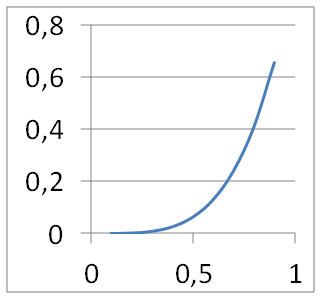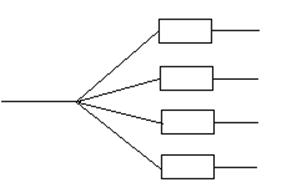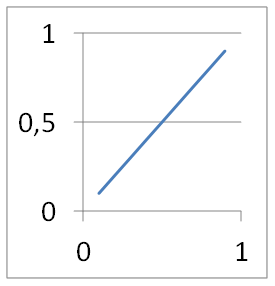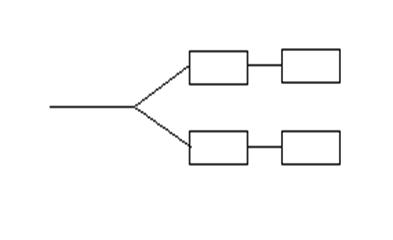The formula for calculating efficiency in physics. efficiency of the internal combustion engine. How much is approximately equal, as well as power in percent
COEFFICIENT OF EFFICIENCY (COP) is a characteristic of the efficiency of a system (device, machine) in relation to energy conversion; is determined by the ratio of useful energy used (turned into work in a cyclic process) to the total amount of energy transferred to the system.
Coefficient useful action
(efficiency), a characteristic of the efficiency of a system (device, machine) in relation to the conversion or transfer of energy; is determined by the ratio of useful energy used to the total amount of energy received by the system; usually denoted by h = Wpol/Wcym.
In electric motors, efficiency is the ratio of the performed (useful) mechanical work to the electrical energy received from the source; in heat engines ≈ the ratio of useful mechanical work to the amount of heat expended; in electrical transformers ≈ the ratio of electromagnetic energy received in the secondary winding to the energy consumed by the primary winding. To calculate the efficiency different types energy and mechanical work are expressed in the same units based on the mechanical equivalent of heat, and other similar ratios. Due to its generality, the concept of efficiency makes it possible to compare and evaluate from a unified point of view such different systems as nuclear reactors, electric generators and engines, thermal power plants, semiconductor devices, biological objects, etc.
Due to the inevitable energy losses due to friction, heating of surrounding bodies, etc., the efficiency is always less than unity. Accordingly, the efficiency is expressed in fractions of the energy expended, i.e., in the form proper fraction or as a percentage, and is a dimensionless quantity. The efficiency of thermal power plants reaches 35≈40%, internal combustion engines ≈ 40≈50%, high power dynamos and generators ≈95%, transformers ≈98%. The efficiency of the photosynthesis process is usually 6≈8%, in chlorella it reaches 20≈25%. For heat engines, due to the second law of thermodynamics, the efficiency has an upper limit determined by the features of the thermodynamic cycle (circular process) that the working substance performs. The Carnot cycle has the highest efficiency.
A distinction is made between the efficiency of an individual element (stage) of a machine or device and the efficiency that characterizes the entire chain of energy transformations in the system. The efficiency of the first type, in accordance with the nature of energy conversion, can be mechanical, thermal, etc. The second type includes general, economic, technical, and other types of efficiency. The overall efficiency of the system is equal to the product of the partial efficiencies, or the efficiency of the steps.
In the technical literature, the efficiency is sometimes determined so that it can be greater than unity. A similar situation arises if we determine the efficiency by the ratio Wpol/Wcont, where Wcont ≈ the energy used, obtained at the "output" of the system, Wcont ≈ not all the energy entering the system, but only that part of it, for which real costs are incurred. For example, during the operation of semiconductor thermoelectric heaters (heat pumps), the consumption of electricity is less than the amount of heat released by the thermoelement. The excess energy is drawn from environment. In this case, although the true efficiency of the plant is less than unity, the considered efficiency h = Wpol/Wzap may be greater than unity.
Lit .: Artobolevsky I. I., Theory of mechanisms and machines, 2nd ed., M.≈ L., 1952; General Heat Engineering, ed. S. Ya. Kornitsky and Ya. M. Rubinshtein, 2nd ed., M.≈ L., 1952; General electrical engineering, M.≈ L., 1951; Vukalovich M. P., Novikov I. I., Technical thermodynamics, 4th ed., M., 1968.
Wikipedia
Efficiency
Efficiency (efficiency) - a characteristic of the efficiency of the system in relation to the conversion or transfer of energy. It is determined by the ratio of useful energy used to the total amount of energy received by the system; usually denoted by η. Efficiency is a dimensionless quantity and is often measured as a percentage.
In reality, the work done with the help of any device is always more useful work, since part of the work is done against the friction forces that act inside the mechanism and when moving its individual parts. So, using a movable block, they perform additional work, lifting the block itself and the rope and, overcoming the friction forces in the block.
We introduce the following notation: we denote useful work by $A_p$, and complete work by $A_(poln)$. In doing so, we have:
Definition
Coefficient of performance (COP) called the ratio of useful work to full. We denote the efficiency by the letter $\eta $, then:
\[\eta =\frac(A_p)(A_(poln))\ \left(2\right).\]
Most often, the efficiency is expressed as a percentage, then its definition is the formula:
\[\eta =\frac(A_p)(A_(poln))\cdot 100\%\ \left(2\right).\]
When creating mechanisms, they try to increase their efficiency, but mechanisms with an efficiency equal to one (and even more than one) do not exist.
So, the efficiency factor is physical quantity, which shows the proportion that useful work is from all the work produced. With the help of efficiency, the efficiency of a device (mechanism, system) that converts or transmits energy that performs work is evaluated.
To increase the efficiency of mechanisms, you can try to reduce the friction in their axes, their mass. If friction can be neglected, the mass of the mechanism is significantly less than the mass, for example, of the load that the mechanism lifts, then the efficiency is slightly less than unity. Then the work done is approximately equal to the useful work:
The golden rule of mechanics
It must be remembered that a gain in work cannot be achieved using a simple mechanism.
Let us express each of the works in formula (3) as the product of the corresponding force by the path traveled under the influence of this force, then we transform formula (3) into the form:
Expression (4) shows that using a simple mechanism, we gain in strength as much as we lose on the way. This law is called the "golden rule" of mechanics. This rule was formulated in ancient Greece by Heron of Alexandria.
This rule does not take into account the work to overcome friction forces, therefore it is approximate.
Efficiency in power transmission
The efficiency factor can be defined as the ratio of useful work to the energy expended on its implementation ($Q$):
\[\eta =\frac(A_p)(Q)\cdot 100\%\ \left(5\right).\]
To calculate the efficiency of a heat engine, the following formula is used:
\[\eta =\frac(Q_n-Q_(ch))(Q_n)\left(6\right),\]
where $Q_n$ is the amount of heat received from the heater; $Q_(ch)$ - the amount of heat transferred to the refrigerator.
The efficiency of an ideal heat engine that operates according to the Carnot cycle is:
\[\eta =\frac(T_n-T_(ch))(T_n)\left(7\right),\]
where $T_n$ - heater temperature; $T_(ch)$ - refrigerator temperature.
Examples of tasks for efficiency
Example 1
Exercise. The crane engine has a power of $N$. For a time interval equal to $\Delta t$, he lifted a load of mass $m$ to a height $h$. What is the efficiency of the crane?\textit()
Solution. Useful work in the problem under consideration is equal to the work of lifting the body to a height $h$ of a load of mass $m$, this is the work of overcoming the force of gravity. It is equal to:
The total work that is done when lifting a load can be found using the definition of power:
Let's use the definition of the efficiency factor to find it:
\[\eta =\frac(A_p)(A_(poln))\cdot 100\%\left(1.3\right).\]
We transform formula (1.3) using expressions (1.1) and (1.2):
\[\eta =\frac(mgh)(N\Delta t)\cdot 100\%.\]
Answer.$\eta =\frac(mgh)(N\Delta t)\cdot 100\%$
Example 2
Exercise. Ideal gas executes a Carnot cycle, while the efficiency of the cycle is equal to $\eta $. What is the work in a gas compression cycle at constant temperature? The work done by the gas during expansion is $A_0$
Solution. The efficiency of the cycle is defined as:
\[\eta =\frac(A_p)(Q)\left(2.1\right).\]
Consider the Carnot cycle, determine in which processes heat is supplied (it will be $Q$).
Since the Carnot cycle consists of two isotherms and two adiabats, we can immediately say that there is no heat transfer in adiabatic processes (processes 2-3 and 4-1). In isothermal process 1-2 heat is supplied (Fig.1 $Q_1$), in isothermal process 3-4 heat is removed ($Q_2$). It turns out that in expression (2.1) $Q=Q_1$. We know that the amount of heat (the first law of thermodynamics) supplied to the system during an isothermal process goes completely to perform work by the gas, which means:
The gas performs useful work, which is equal to:
The amount of heat that is removed in the isothermal process 3-4 is equal to the work of compression (the work is negative) (since T=const, then $Q_2=-A_(34)$). As a result, we have:
We transform the formula (2.1) taking into account the results (2.2) - (2.4):
\[\eta =\frac(A_(12)+A_(34))(A_(12))\to A_(12)\eta =A_(12)+A_(34)\to A_(34)=( \eta -1)A_(12)\left(2.4\right).\]
Since by condition $A_(12)=A_0,\ $finally we get:
Answer.$A_(34)=\left(\eta -1\right)A_0$
The concept of efficiency (COP) can be applied to a wide variety of types of devices and mechanisms, the operation of which is based on the use of any resources. So, if we consider the energy used for the operation of the system as such a resource, then the result of this should be considered the amount of useful work performed on this energy.In general terms, the efficiency formula can be written as follows: n = A*100%/Q. In this formula, the symbol n is used as a designation for efficiency, symbol A represents the amount of work done, and Q is the amount of energy expended. At the same time, it should be emphasized that the unit of measurement of efficiency is percent. Theoretically, the maximum value of this coefficient is 100%, but in practice it is almost impossible to achieve such an indicator, since certain energy losses are present in the operation of each mechanism.
Engine efficiency
The internal combustion engine (ICE), which is one of the key components of the mechanism of a modern car, is also a variant of a system based on the use of a resource - gasoline or diesel fuel. Therefore, it is possible to calculate the efficiency value for it.
Despite all the technical achievements of the automotive industry, the standard efficiency of internal combustion engines remains quite low: depending on the technologies used in the design of the engine, it can be from 25% to 60%. This is due to the fact that the operation of such an engine is associated with significant energy losses.
Thus, the greatest losses in the efficiency of the internal combustion engine occur in the operation of the cooling system, which takes up to 40% of the energy generated by the engine. A significant part of the energy - up to 25% - is lost in the process of removing exhaust gases, that is, it is simply carried away into the atmosphere. Finally, about 10% of the energy generated by the engine goes to overcome the friction between the various parts of the internal combustion engine.
Therefore, technologists and engineers employed in the automotive industry are making significant efforts to improve the efficiency of engines by reducing losses in all of the above items. Thus, the main direction of design developments aimed at reducing losses related to the operation of the cooling system is associated with attempts to reduce the size of the surfaces through which heat transfer occurs. The reduction of losses in the process of gas exchange is carried out mainly using a turbocharging system, and the reduction of losses associated with friction is carried out through the use of more technological and modern materials when designing an engine. According to experts, the use of these and other technologies can raise the efficiency of internal combustion engines to the level of 80% and above.
Calculation of the efficiency of the machine unit
Machine unit - A set of engine mechanisms, transmission mechanisms and mechanisms of a working machine.
Let us consider a separately established motion. For each complete cycle of this movement, the increment in kinetic energy is zero:
∑(mv2)/2-∑(mv02)/2=0 (1)
Mechanical efficiency (efficiency) is the ratio of the absolute value of the work of the forces of production resistance to the work of all driving forces for a cycle of steady motion. Accordingly, the formula can be written:
K.P.D. is determined by the formula: η=Ап. s/Hell (2)
Where: Aps - the work of production forces;
Hell is the work of driving forces.
The ratio of work AT of non-production resistances to the work of driving forces is usually denoted by Ψ and called the coefficient of mechanical losses. Accordingly, the formula can be written as follows:
η \u003d AT / AD \u003d 1 - Ψ (3)
The less non-productive resistances in the mechanism of work, the lower its loss coefficient and the more perfect the mechanism in terms of energy.
It follows from the equation: since in no mechanism the work of AT is not the production forces of resistance, friction forces (frost friction, sliding friction, dry, semi-dry, liquid, semi-liquid), practically cannot equal zero, then the efficiency cannot equal zero .
From formula (2) it follows that the efficiency can be equal to zero if
This means that the efficiency is equal to zero if the work of the driving forces is equal to the work of all the forces of non-productive resistances that are present in the mechanism. In this case, movement is possible, but without doing any work. This movement of the mechanism is called idle movement.
Efficiency cannot be less than zero, since for this it is necessary that the ratio of work AT / IM be greater than one:
AT / BP >1 or AT > BP
From these inequalities it follows that if the mechanism that satisfies the specified condition is at rest, then real motion cannot occur. This phenomenon is called Self-braking mechanism. If the mechanism is in motion. Then, under the influence of non-productive resistance forces, it will gradually slow down its progress until it stops (slows down). Consequently, obtaining a negative value of efficiency in theoretical calculations is a sign of self-braking of the mechanism or the impossibility of movement in a given direction.
Thus, the efficiency of the mechanism can vary within:
0 ≤η< 1 (4)
From formula (2) it follows that the efficiency Ψ varies within: 0 ≤η< 1
The relationship of machines in the machine unit.
Each machine is a complex of mechanisms connected in a certain way, and some complex ones can be divided into simpler ones, then having the ability to calculate K.P.D. simple mechanisms or having at their disposal certain values of K.P.D. simple mechanisms, you can find a complete K.P.D. machines, made up of simple elements in any combination of them.
All possible cases of transfer of motion and force can be divided into cases: series, parallel and mixed connection.
When calculating K.P.D. connections, we will take an aggregate consisting of four mechanisms of which: N1=N2=N3=N4, η1=η2=η3=η4=0.9
We accept the driving force (BP) = 1.0
Consider K.P.D. serial connection.
 The first mechanism is set in motion by driving forces that do the work of Hell. Since the useful work of each previous mechanism, spent on production resistances, is the work of the driving forces for each subsequent one, then K.P.D. η of the first mechanism is:
The first mechanism is set in motion by driving forces that do the work of Hell. Since the useful work of each previous mechanism, spent on production resistances, is the work of the driving forces for each subsequent one, then K.P.D. η of the first mechanism is:
Second - η \u003d A2 / A1
Third - η \u003d A3 / A2
Fourth - η \u003d A4 / A3
Overall efficiency η1n=An/Ad
The value of this efficiency factor can be obtained by multiplying all individual efficiency factors η1, η2, η3, η4. We have
η=η1*η2*η3*η4=(A1/AD)*(A2/A1)*(A3/A2)*(A4/A3)=An/AD (5)
Thus, the overall mechanical efficiency of the series connection of mechanisms is equal to the product of the mechanical efficiency of the individual mechanisms that make up one common system.
η=0.9*0.9*0.9*0.9=0.6561=Ap. With.
Consider K.P.D. parallel connection.
 When mechanisms are connected in parallel, there may be two cases: from one source of motive power, power is transmitted to several consumers, several sources feed one consumer in parallel. But we will consider the first option.
When mechanisms are connected in parallel, there may be two cases: from one source of motive power, power is transmitted to several consumers, several sources feed one consumer in parallel. But we will consider the first option.
With this connection: Ap. s.=A1+A2+A3+A4

If K.P.D. each mechanism has the same then and the power will be distributed equally to each mechanism: ∑КI=1 then ⇒ К1=К2=К3=К4=0.25.
Then: η=∑Кi*ηi (6)
η =4(0.25*0.90)=0.90
Thus, the overall K.P.D. parallel connection as the sum of the products of each individual section of the unit chain.
Consider the efficiency of a mixed compound.
 In this case, there is both serial and parallel connection of mechanisms.
In this case, there is both serial and parallel connection of mechanisms.
In this case, the power Ad is transferred to two mechanisms (1.3), and from them to the rest (2.4)
Because η1*η2=A2 and η3*η4=A4, and K1=K2=0.5
 The sum of A2 and A4 is equal to Ap. With. then from formula (1) one can find the K.P.D. systems
The sum of A2 and A4 is equal to Ap. With. then from formula (1) one can find the K.P.D. systems
η=К1*η1*η2+К2*η3*η4 (7)
η=0.5*0.9*0.9+0.5*0.9*0.9=0.405+0.405=0.81
Thus, the overall K.P.D. mixed connection is equal to the sum of the products of the mechanical coefficients connected in series multiplied by the part of the driving force.
Ways to improve efficiency
Now the main efforts of engineers are aimed at increasing the efficiency of engines by reducing the friction of their parts, fuel losses due to incomplete combustion, etc. The real possibilities for increasing the efficiency here are still large, the actions are equal to: The actual value of the efficiency due to various kinds energy losses are approximately equal to 40%. The maximum efficiency - about 44% - have internal combustion engines. The efficiency of any heat engine cannot exceed the maximum possible value of 40-44%.
Conclusion: when considering each connection of mechanisms separately, we can say that the highest efficiency of a parallel connection is equal to η=0.9. Therefore, in aggregates, you should try to use a parallel connection or as close as possible to it.
Efficiency calculation - 4.0 out of 5 based on 3 votes
This article will focus on the familiar, but many do not understand the term coefficient of performance (COP). What is it? Let's figure it out. Coefficient of performance, hereinafter referred to as (COP) - a characteristic of the efficiency of the system of any device, in relation to the conversion or transfer of energy. It is determined by the ratio of useful energy used to the total amount of energy received by the system. Is it usually marked? (" this"). ? = Wpol/Wcym. Efficiency is a dimensionless quantity and is often measured as a percentage. Mathematically, the definition of efficiency can be written as: n \u003d (A: Q) x100%, where A is useful work, and Q is work expended. By virtue of the law of conservation of energy, the efficiency is always less than unity or equal to it, that is, it is impossible to get more useful work than the energy expended! Looking through different sites, I am often surprised how radio amateurs report, or rather, praise their designs, for high efficiency, without having a clue what it is! For clarity, using an example, we will consider a simplified converter circuit, and learn how to find the efficiency of a device. A simplified diagram is shown in Fig. 1Suppose we took as a basis a step-up DC / DC voltage converter (hereinafter referred to as PN), from unipolar to increased unipolar. We turn on the PA1 ammeter in the power circuit break, and in parallel with the power input PN the PA2 voltmeter, the readings of which are needed to calculate the power consumption (P1) of the device and the load together from the power source. To the PN output, we also turn on the RAZ ammeter and the RA4 voltmeter, which are required to calculate the power consumed by the load (P2) from the PN, to the power supply break of the load. So, everything is ready for calculating the efficiency, then let's get started. We turn on our device, measure the readings of the instruments and calculate the powers P1 and P2. Hence P1=I1 x U1, and P2=I2 x U2. Now we calculate the efficiency using the formula: Efficiency (%) = P2: P1 x100. Now you have learned about the real efficiency of your device. Using a similar formula, you can calculate the PN and with a two-polar output according to the formula: Efficiency (%) \u003d (P2 + P3): P1 x100, as well as a step-down converter. It should be noted that the value (P1) also includes the current consumption, for example: a PWM controller, and (or) a driver for controlling field-effect transistors, and other structural elements.

For reference: car amplifier manufacturers often indicate the output power of the amplifier is much higher than in reality! But, you can find out the approximate real power of the car amplifier using a simple formula. Let's say on the auto amplifier in the + 12v power circuit, there is a 50 A fuse. We calculate, P \u003d 12V x 50A, in total we get a power consumption of 600 watts. Even in high-quality and expensive models, the efficiency of the entire device is unlikely to exceed 95%. After all, part of the efficiency is dissipated in the form of heat on powerful transistors, transformer windings, rectifiers. So let's get back to the calculation, we get 600 W: 100% x92 = 570W. Therefore, no matter what 1000 W or even 800 W, as the manufacturers write, this car amplifier will not give out! I hope this article will help you understand such a relative value as efficiency! Good luck to everyone in the development and repetition of designs. You had an inverter with you.
